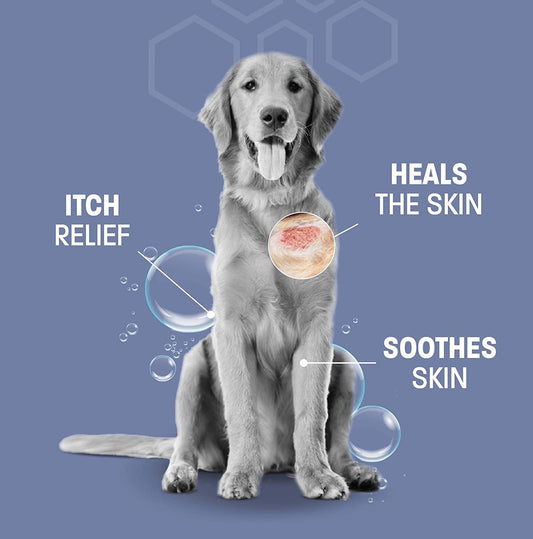Taking care of your dog's ears is super important for their overall health. Using ear drops can help keep their ears clean and free from infections. This article will guide you through everything you need to know about dog ear drops, from choosing the right type to applying them correctly.
Key Takeaways
- Dog ear drops help keep your dog's ears clean and can prevent infections.
- Look for common ingredients like antibiotics and antifungals in ear drops.
- Watch for signs like itching or bad smells that indicate your dog might need ear drops.
- Always consult your vet before choosing and using ear drops for your dog.
- Properly applying ear drops involves preparing your dog, following steps carefully, and monitoring for side effects.
Understanding Dog Ear Drops
What Are Dog Ear Drops?
Dog ear drops are liquid solutions designed to treat various ear problems in dogs. They help in cleaning, medicating, and soothing the ear canal. These drops can address issues like infections, inflammation, and wax buildup.
Common Ingredients in Dog Ear Drops
Dog ear drops often contain a mix of active and inactive ingredients. Some common active ingredients include:
- Antibiotics: To fight bacterial infections
- Antifungals: To treat yeast infections
- Steroids: To reduce inflammation and itching
Inactive ingredients might include water, glycerin, and alcohol, which help in delivering the active ingredients effectively.
How Dog Ear Drops Work
Dog ear drops work by delivering medication directly into the ear canal. This allows the active ingredients to target the problem area quickly. For example, antibiotics in the drops can kill bacteria causing an infection, while steroids can reduce swelling and discomfort. Regular use as directed by a vet can help maintain ear health and prevent future issues.
Keeping your dog's ears clean and dry is crucial for preventing infections. Regular ear cleaning and using vet-recommended products can make a big difference.
Identifying Ear Problems in Dogs
Signs Your Dog Needs Ear Drops
Recognizing when your dog needs ear drops is crucial for maintaining their ear health. Common signs include scratching their ears, shaking their head, and rubbing their ears on furniture. You might also notice redness, swelling, or an unusual odor coming from their ears.
Common Ear Issues in Dogs
Dogs can suffer from various ear problems, such as infections, mites, and allergies. Ear infections are often caused by bacteria or yeast and can lead to significant discomfort. Mites are tiny parasites that can cause intense itching and inflammation. Allergies, whether environmental or food-related, can also result in ear issues.
When to Consult a Veterinarian
It's important to know when to seek professional help. If your dog's symptoms persist for more than a few days or worsen, it's time to consult a veterinarian. Persistent symptoms like severe pain, discharge, or hearing loss should not be ignored. A vet can provide a proper diagnosis and recommend the best treatment plan.
Early detection and treatment of ear problems can prevent more serious health issues down the line. Always keep an eye on your dog's behavior and ear condition to ensure they stay healthy and happy.
Choosing the Right Dog Ear Drops
Types of Dog Ear Drops
Dog ear drops come in various types, each designed to address specific issues. Antibacterial drops are used to treat bacterial infections, while antifungal drops target yeast infections. There are also anti-inflammatory drops that help reduce swelling and pain. It's important to choose the right type based on your dog's specific needs.
Reading Labels and Ingredients
When selecting ear drops, always read the labels carefully. Look for active ingredients like hydrocortisone for inflammation or miconazole for fungal infections. Avoid products with alcohol as they can cause irritation. Understanding the ingredients will help you make an informed choice.
Consulting Your Veterinarian for Recommendations
Before starting any ear drop treatment, consult your veterinarian. They can provide recommendations based on your dog's medical history and current condition. Your vet can also guide you on the proper dosage and application method, ensuring the treatment is both safe and effective.
Regular ear cleaning can prevent yeast build-up, which is a common cause of ear infections in dogs. Always follow your vet's advice for the best results.
How to Properly Administer Dog Ear Drops
Preparing Your Dog for Ear Drops
Before you start, make sure your dog is calm and comfortable. Gently pet and talk to your dog to help them relax. Gather all the necessary supplies, including the ear drops, cotton balls, and treats for rewarding your dog afterward.
Step-by-Step Guide to Applying Ear Drops
- Read the instructions on the ear drops bottle carefully.
- Hold your dog still by gently wrapping your arm around their body.
- Lift your dog's ear flap to expose the ear canal.
- Place the prescribed number of drops into the ear canal.
- Gently massage the base of the ear to help the drops spread evenly.
- Allow your dog to shake their head, which helps to dislodge any debris.
- Wipe away any excess liquid with a cotton ball.
Post-Application Care and Monitoring
After applying the ear drops, keep an eye on your dog for any signs of discomfort or adverse reactions. Reward your dog with a treat to create a positive association with the process. Check the ear regularly for improvements or any signs of infection. If you notice any unusual symptoms, contact your veterinarian immediately.
Proper administration of ear drops is crucial for your dog's ear health. Following these steps can help ensure effective treatment and a stress-free experience for both you and your pet.
Preventing Ear Problems in Dogs
Routine Ear Cleaning Tips
Regular ear cleaning is essential to prevent ear problems in dogs. Cleaning your dog's ears once a week can help remove dirt, wax, and other debris that might cause infections. Use a vet-recommended ear cleaner and avoid inserting anything deep into the ear canal.
Diet and Nutrition for Healthy Ears
A balanced diet plays a crucial role in maintaining your dog's ear health. Foods rich in omega-3 fatty acids, vitamins, and minerals can boost the immune system and reduce inflammation. Consider adding fish oil or flaxseed to your dog's diet for better ear health.
Regular Veterinary Check-Ups
Routine check-ups with your veterinarian are vital for early detection of ear problems. During these visits, the vet can examine your dog's ears and provide professional cleaning if needed. Early detection and treatment can prevent minor issues from becoming serious health problems.
Keeping your dog's ears healthy requires a combination of regular cleaning, proper diet, and routine vet visits. By following these steps, you can help ensure your furry friend stays happy and healthy.
Potential Side Effects and Risks
Recognizing Adverse Reactions
When using dog ear drops, it's important to watch for any adverse reactions. Common signs include redness, swelling, or increased itching in the ear area. Your dog might also shake its head more than usual or show signs of discomfort. If you notice any of these symptoms, stop using the drops and consult your veterinarian.
What to Do If Side Effects Occur
If your dog experiences side effects, follow these steps:
- Stop using the ear drops immediately.
- Gently clean your dog's ear with a soft cloth to remove any remaining medication.
- Contact your veterinarian for advice on how to proceed.
- Monitor your dog closely for any worsening symptoms or new reactions.
Minimizing Risks with Proper Use
To minimize risks, always use ear drops as directed by your veterinarian. Here are some tips:
- Read the label carefully to ensure you understand the dosage and application instructions.
- Avoid using ear drops meant for humans or other animals, as they may contain ingredients harmful to dogs.
- Store ear drops in a cool, dry place to maintain their effectiveness.
Proper use of dog ear drops can help keep your pet's ears healthy while reducing the risk of side effects. Always consult your veterinarian if you have any concerns or questions.
Natural and Alternative Remedies
Herbal and Homeopathic Options
Herbal and homeopathic remedies can be a gentle way to treat your dog's ear problems. These options often use natural ingredients like calendula, chamomile, and tea tree oil. They aim to reduce inflammation and fight infections without harsh chemicals.
Pros and Cons of Natural Remedies
Natural remedies have their benefits and drawbacks. Here are some points to consider:
Pros:
- Fewer side effects
- Gentle on the skin
- Often less expensive
Cons:
- May take longer to show results
- Not always as effective as medicated drops
- Limited scientific research
When to Use Alternative Treatments
Alternative treatments can be useful, but they are not always the best choice. Use them for mild issues or as a preventive measure. Always consult your veterinarian before starting any new treatment to ensure it's safe for your dog.
It's important to monitor your dog's reaction to any new treatment and consult your vet if you notice any adverse effects.
Discover the power of natural and alternative remedies for your pets. Our products are designed to improve their health and well-being without the need for harsh chemicals. Visit our website to explore our range of pet health solutions and find the perfect fit for your furry friend.
Conclusion
Taking care of your dog's ears is super important to keep them happy and healthy. Using ear drops the right way can help prevent infections and other ear problems. Always talk to your vet before starting any new treatment. Remember, clean ears mean a happy dog!
Frequently Asked Questions
What are dog ear drops?
Dog ear drops are liquid medications used to treat various ear problems in dogs, such as infections, inflammation, and ear mites.
How do I know if my dog needs ear drops?
If your dog is scratching their ears a lot, shaking their head, or if you notice a bad smell or discharge, they might need ear drops. It's best to check with your vet.
Can I use human ear drops on my dog?
No, you should not use human ear drops on your dog. Dog ear drops are specially made for their needs and using the wrong kind can harm your pet.
How do I apply ear drops to my dog?
First, make sure your dog is calm. Hold their ear up and put the drops in as directed by your vet. Gently massage the base of the ear to help the drops go in.
Are there natural remedies for dog ear problems?
Yes, there are natural remedies like herbal and homeopathic options. However, you should always talk to your vet before trying these to make sure they're safe for your dog.
What should I do if my dog has a bad reaction to ear drops?
If your dog shows signs of a bad reaction, like more redness, swelling, or pain, stop using the drops and contact your vet right away.









